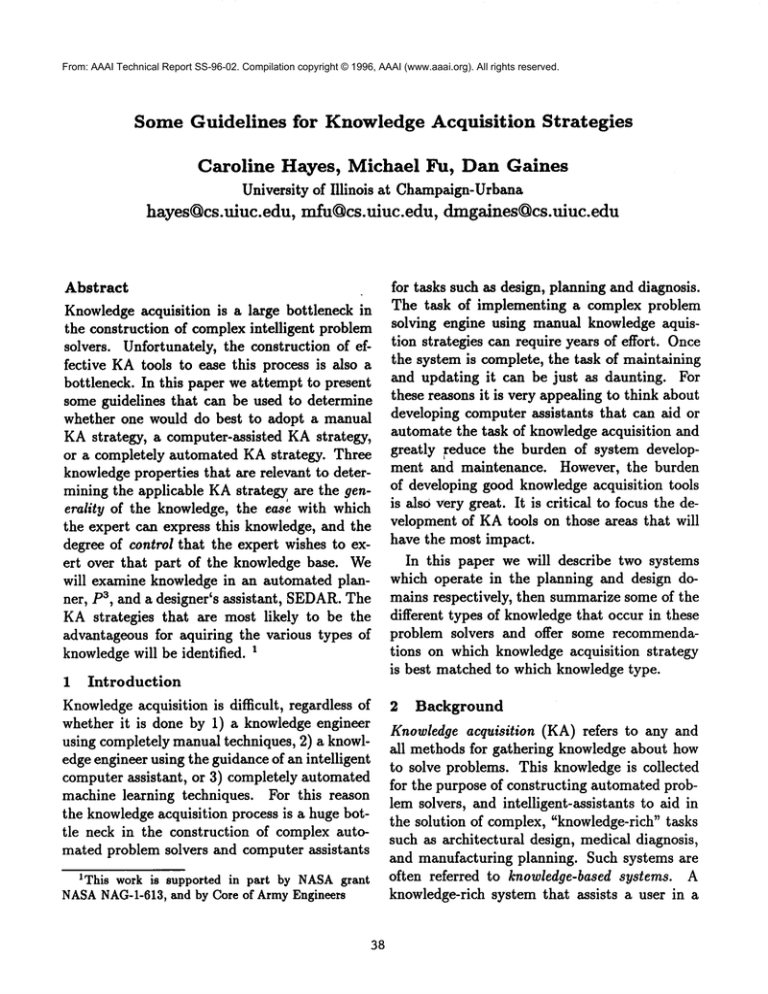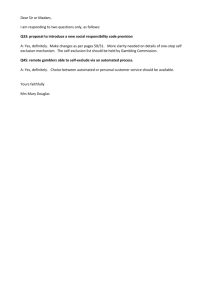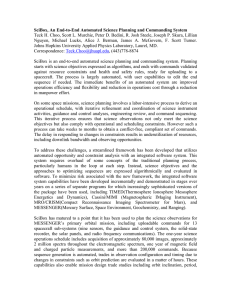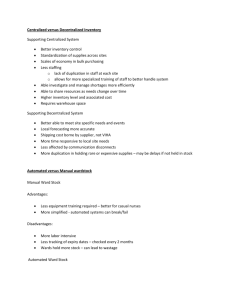Some Guidelines for Knowledge Acquisition
advertisement

From: AAAI Technical Report SS-96-02. Compilation copyright © 1996, AAAI (www.aaai.org). All rights reserved. Some Guidelines for Knowledge Acquisition Strategies Caroline Hayes, Michael Fu, Dan Gaines University of Illinois at Champaigu-Urhana hayes~cs.uiuc.edu, mfu@cs.uiuc.edu, dmgaines~cs.uiuc.edu Abstract Knowledgeacquisition is a large bottleneck in the construction of complex intelligent problem solvers. Unfortunately, the construction of effective KAtools to ease this process is also a bottleneck. In this paper we attempt to present some guidelines that can be used to determine whether one would do best to adopt a manual KAstrategy, a computer-assisted KAstrategy, or a completely automated KAstrategy. Three knowledgeproperties that are relevant to determining the applicable KAstrateg.y are the generality of the knowledge, the ease with which the expert can express this knowledge, and the degree of control that the expert wishes to exert over that part of the knowledge base. We will examine knowledge in an automated planner, p3, and a designer’s assistant, SEDAR. The KAstrategies that are most likely to be the advantageous for aquiring the various types of knowledgewill be identified. 1 1 Introduction Knowledgeacquisition is difficult, regardless of whether it is done by 1) a knowledge engineer using completely manual techniques, 2) a knowledge engineer using the guidance of an intelligent computer assistant, or 3) completely automated machine learning techniques. For this reason the knowledgeacquisition process is a huge bottle neck in the construction of complex automated problem solvers and computer assistants 1This work is supported in part by NASA grant NASA NAG-I-613,and by Core of ArmyEngineers 38 for tasks such as design, planning and diagnosis. The task of implementing a complex problem solving engine using manual knowledge aquistion strategies can require years of effort. Once the system is complete, the task of maintaining and updating it can be just as daunting. For these reasons it is very appealing to think about developing computer assistants that can aid or automate the task of knowledge acquisition and greatly reduce the burden of system development and maintenance. However, the burden of developing good knowledge acquisition tools is als0 very great. It is critical to focus the development of KAtools on those areas that will have the most impact. In this paper we will describe two systems which operate in the planning and design domains respectively, then summarize some of the different types of knowledgethat occur in these problem solvers and offer some recommendations on which knowledge acquisition strategy is best matched to which knowledge type. 2 Background Knowledge acquisition (KA) refers to any and o.ll methods for gathering knowledgeabout how to solve problems. This knowledge is collected for the purpose of constructing automated problem solvers, and intelligent-assistants to aid in the solution of complex, "knowledge-rich" tasks such as architectural design, medical diagnosis, and manufacturing planning. Such systems are often referred to knowledge-based systems. A knowledge-rich system that assists a user in a fort required to construct knowledge-basedtools [MM891,[Esh88]. In totally automated knowledge acquisition systems, the KAsystem (rather then the knowledge engineer or domain expert) automatically formulates rules which encode problem solving knowledge, and some times domain concepts, as well. Such a system may work from examples provided by an expert, or it maypassively observe the expert solving problems. Such systems could potentially reduce the burden on knowledge engineers and domain experts even further, but they are difficult to construct effectively. problemsolving task (in contrast to systems that automate tasks) is called an intelligent computer assistant. Problem solving knowledge could be collected either from a practitioner who is an expert in solving a particular class of problems,or it could be collected from a set of problem solving examples. The practitioner, who’s problem solving methods are studied, is referred to as the domain expert. A person who collects knowledge from a domain expert is known as a knowledge engineer. Sometimes, the user of a knowledge-basedtool is also a domain expert and possibly a knowledge engineer as well. In such cases, the tool is used to magnify or multiply the abilities of the expert-user. In other cases, the user is relatively inexperienced in the problem area and the knowledge-based tool is used to enable the novice-user to solve problems which they would otherwise lack the knowledgeto solve. Knowledge Aquistion Strategies. Knowledge acquisition can happen through a wide variety of strategies that vary continuously from completely manual to totally automated. In manual strategies, knowledge engineers interview domain experts in order to understand their problem solving methods. The knowledge engineers summarizethe information they learn in the form of rules or programstatements. This is a very flexible strategy for knowledgeacquisition. It was also the only strategy available for constructing early knowledge-basedsystems. However,for manytasks it is also quite tedious and time consuming. In computer-assisted knowledge acquisition, an intelligent computer assistant aides in the process of collecting rules and data and forming them into program statements. Such knowledge acquisition tools may guide a knowledge engineer through the process, or they may allow a domainexpert to interact directly with the system, reducing the need for a knowledgeengineer. Such systems, where they have been successfully applied, have greatly reduced the time and ef- 3 Knowledge Properties There are a numberof properties that influence the appropriateness of utilizing a given knowledge acquisition strategy to acquire a given knowledge type. The following list of properties represents the ones we have observed to be important in the problem domains we have studied. These properties include the: ¯ Generality of knowledge to a broad or narrow family of problem domains. ¯ Ease in expressing knowledge concepts experienced by domain experts. ¯ Degree of control desired by expert/user over knowledgein a part of the system. 39 Generality of knowledge refers to the size of the family of problems to which the knowledge applies. Knowledgemaybe specific to a broad family of related domains, a single domain, or even to a single user. One can view problem solvers as belonging to a taxonomy of problem solving families. Within one problem solving system one may find some knowledge that may be very specific to one narrow domain such as roofing design, some that is shared by a broader problem solving family such as the family of mechanical design problems, and some that is general to almost all problem solvers. It may be desirable to customize a system not only to a specific problem domain, but also to a specific user groupor even to a single user. User knowledge includes items such as user preferences in task ordering and preferences in operator selection. Contrary to what some people may presume, the moregeneral the knowledge, the less utility there may be in developing an specialized tool to acquire that knowledge. If the knowledge will only be codified once and will be reused many times, then manual knowledge acquisition strategies maybe most appropriate. Automated and computer-assisted KAtools are probably most useful in specializing general frameworks developed for families of problem solvers into high performance, domain specific problem solvers. A well designed KAtool can be reused manytimes to specialize the frameworkinto several specific domains. The ability to specialize a system to meet the preference of a particular user maybe important in achieving user acceptance of a system. Users feel comfortable and confident in using a tool if they can feel that they "own" it, in the sense that they can customize it to meet their specific needs. Since it is the users (who are often also experts), and not the system, whois ultimately responsible for the correctness and quality of the solutions it is important that the user be able to tune the system to the specific companypractices, properties of their ownfacility, or personal preferences. Ease in expressing concepts. Another factor influencing the applicability of automated and computer-assisted knowledge acquisition tools is the ease or difficulty that experts experience in expressing concepts relevant to particular knowledgetypes. If experts can easily articulate concepts accurately, then the most appropriate strategies may be either either manual or computer-assisted. These strategies allow the user to interact directly with the knowledgebase. If concepts are hard for the expert to articulate directly, a computer-assisted strategy may not be appropriate. However,it maybe possible 4o for a knowledgeengineer to tease these concepts out by numerous examples. This is a highly tedious task for humanknowledge engineers to perform manually. In this case, a totally automated strategy may be very useful that can generalize the solutions given by an expert in response to examples. It is important to note, however, that sometimes a concept maybe difficult for the expert to express because the computer formulation of the problem is not well suited to task. Wefound this to be the case in the planning case-study that will be described later. Reformulation of the problem turned a hard-to-elicit concept into an easy-to-elicit one. Degree of control desired by expert/user over knowledge in system. The degree of control desired by experts and users may also influence what type of KAtechnique is appropriate. There are some types of knowledge that users have no great desire to examine provided that system performance appears to be correct. However,frequently, experts and users want to be able to inspect muchof the knowledgein the system, and to correct it if it is not to their standards. Users mayloose some control over what knowledge is acquired when completely automated KAtechniques are used. However, is such strategies can also provide a wayfor users to offer corrective inputs then automated techniques maystill be applicable even whenusers desire a high degree of control. Figure 1 summarizes the relationship of knowledgeproperties to the three knowledgeacquisition strategies. Eachof the three properties is shown on one axis. The shaded zones indicate which KAstrategy is most applicable for a given combination of properties. For example, suppose one wishes to add domain specific knowledge to a general problem solving framework in order to specialize it. Also suppose that it is easy for the expert to articulate this knowledge, and the system developer wants to repeat this process for several domains. Then it may appropriate to develop a computer-assisted KA tool that will guide an expert in entering knowledge. ria for a desirable plan, and preferences between operator choices. In particular, for this domain we found that 4 Knowledge Domains - Case Studies muchof the knowledge in embodied in the basic Twosystems are described in this section: p3 problem solving architecture was relatively sta[Hay96b] an automated manufacturing planner, ble across closely related domains. Development and SEDAR [FHE96], an intelligent support tool of the problem solving architectures that apply to aid in the task of roofing design. The inito families of domains maybe best developed by tial implementation of these systems has been manual KAtechniques. done using completely manual strategies, howHowever, it becameapparent that there was a ever it is one of our goals to use automated need to provide some way of modifying the sysstrategies, where possible, to adapt these frameworks to other closely related planning and de- tem to adapt to changes in manufacturing technology. When the manufacturing technology sign domains. These systems will be described in terms of the the types of knowledgethey con- changed, or when we wanted to adapt the planner to slightly different manufacturing tasks, we tain, the properties of that knowledge(general, found it was necessary to change many of the user specific, easy to express, hard to express, etc.) and the knowledge acquisition techniques operator descriptions. This is a task that is tedious for both experts and knowledgeengineers. that are likely to be applicable. So tedious, in fact, that industrial practition4.1 p3: An Automated Manufacturing ers express reluctance to adopt generative planPlanner. ners because of the difficulty of updating and p3 (Positional tolerance Process Planner) is maintaining them. However, the solution we deautomated planner which produces manufacturvised was not to build a KAtool to makeit easing plans for fabrication of metal parts. Its in- ier to enter operators, instead we changed the tended use is either as a manufacturing engirepresentations used by the planner. Instead of neer’s assistant, or as a desinger’s assistant. As a representing domain properties in operators, we designer’s assistant, p3 can provide the designer constructed an operator generator that takes dewith immediate feedback during the design proscriptions of the manufacturing equipment, and cess on their design’s manufacturing feasibility uses that information to generate operators. It and cost [HS95], [Hay96a]. is much easier for the domain expert to enter This planner takes a specification of a mechan- a description of the equipmentand its capabiliical part, and automatically produces a man- ties than it is to enter operator descriptions. By ufacturing plan to fabricate it. All planning changing the representation we turned a difficult tasks in this domain involve a problem solving KAtask into an easy one. frameworkin which the over-all goal (the part) Additionally, there was a need to allow users is subdivided into a number of manufacturing to input their owncriteria for desirable plans, ofsubgoals (holes, slots, pockets, etc), a number ten in the form of preference rules to determine candidate manufacturing methods are generated which operators and trade-offs are preferable in for each sub-goal, interactions between methods a given situation. However, preferences are a are determined, and then lastly methods are setype of knowledgethat is very specific to particlected and sequenced in a near optimal way by ular users. Furthermore, specifying preferences a given set of criteria. Knowledgeused in imple- is a task that users find relatively easy to do. menting this domain included knowledge about Theyalso desire a great deal of control over this the general problem solving architecture, howto task. However,it is very tedious to enter these generate manufacturing operators, how to depreferences by manual KAstrategies. This is termine interactions between operations, crite41 Goodcandidate for Manual KA Goodcandidate for computer-assisted KA Does not / Care Goodcandidate for User guided Automated KA conlrol Easy Hard Goodcandidate for Automated KA I c~ IDomm I U.= Specific I Specific Generality Figure 1: Relationship of knowledge properties 42 to knowledge acquisition strategies Knowledge about design subtasks and their inter-relations, and knowledge about building codes are both very specific to the domain of roofing design. However,by installing a different problem sub-task structure, and a different set of codes, we believe the system could be easily adapted to provide critiquing support in other closely related configuration design tasks. Since both of these knowledge types are easy to express, it maybe appropriate to develop a computer-assisted KAtool to enable experts to quickly and effectively specify this information. a KAtask that is probably very well suited to computer-assisted KAtools. 4.2 SEDAR:A Designer’s Assistant. SEDAR is a desinger’s assistant which provides critiques and intelligent support during the design process. This system is very different than P3 in that P3 automatically generates complete solutions while SEDAR’s function is to guide human designers in generating solutions, and to provide design evaluations or partial solutions when asked. SEDAR allows designers to develop solutions while it tracks their behavior, and provides critiques of the partially developed solution. Thus, SEDARdoes not need to know how to generate complete solutions, but it does need to knowenough about the design task in order to track the user’s progression through the design problem. By modeling the design sub-task structure and tracking the user’s focus within this structure, the system can provide relevant critiques. Relevant critiques are ones that pertain to the user’s current focus of attention. As a counterexample, an irrelevant critique would be one in which the system flags required structures as missing from the design if the designer simply has not gotten to those structures yet. Issues the system needs to address are 1) it must allow each user to flexibly determine the order in which they will address design subtasks, and 2) it must deliver relevant critiques in an unobtrusive way which would not interfere or constrain the user’s problemsolving. The types of knowledge that SEDAR uses to address these goals include: critiquing strategies, design sub-tasks and and their relationships with each other, and knowledgeof building codes. The critiquing strategies used by SEDAR turned out to be a fairly general type of knowledge. The same strategies can be applied to many problem domains. Once acquired by a knowledgeengineer, can be re-used for a variety of related domains. Manual KAtechniques are appropriate for understanding and devising these critiquing strategies. 5 Discussion Devising a good problem solving architecture is an important part of a system’s problem solving knowledge, and is still largely an art. Manual KAstrategies maystill be the best methods for devising the very general and reusable parts of a system. In the manufacturing planning and roof design domains, there turned out to be very little need for completely automated KAstrategies. However, in other domains, such speach in tasks such as correctly pronounce vowel sounds, one could imagine that automated KA/learning techniques, such as neural nets, may be quite applicable. For elicitation of domain and user specific knowledge, computer-assisted KAstrategies maybe most appropriate, especially if the knowledgeis also easy to express, such as equipment properties, sub-task hierarchies, and building codes. 6 Conclusions Knowledgeacquisition is a large bottleneck in the construction of complex intelligent problem solvers. KA tools can greatly reduce system development time, but unfortunately construction of effective KAtools to ease this process is also a bottleneck. In this paper we attempt to present some guidelines that can be used to determine for a given knowledge-type whether one would do best to adopt a manual KAstrategy, a computer-assisted KAstrategy, or a completely 43 automated KAstrategy. Three knowledge properties that are relevant to determining the applicable KAstrategy are the generality of the knowledge, the ease with which the expert can express this knowledge, and the degree of control that the expert wishes to exert over that part of the knowledgebase. Computer assisted KAstrategies lend themselves well to acquiring knowledgethat is both easy for the expert to express, and will be used to specialize a general frameworkto a variety of domains. Completely automated KA strategies are appropriate for similar specializing KAtasks, but which are difficult for the expert to express unless it is through examples. Old fashioned but flexible manual KAstrategies are probably best for obtaining general knowledgelike problem solving architectures and general critiquing strategies. Lastly we examined an automated planner, p3, and a designer’s assistant, SEDAR.Weidentified knowledge types used in these programs, the properties of those knowledgetypes, and the type of KAstrategy that is likely to be the most advantageous in adapting these frameworks to other closely related domains. Robotics and Automation, special issue on Assembly and Task Planning, 1996. [HS95] C. C. Hayes and H. C. Sun. Using a manufacturing constraint network to identify cost-critical areas of designs. Artificial Intelligence for Engineering Design, Analysis, and Manufacturing (AIEDAM): Special Issue on Innovative Approaches to Concurrent Engineering, 9(2), May1995. [MM89] S. Markus and J. McDermott. Salt: A knowledge aquisition language for propose-and-revise systems. Artificial Intelligence, 39(1), 1989. References [Esh88] L. Eshelman. Mole: A Knowledgeaquistion tool for cover-anddifferentiate systems. Kluwer, 1988. [FHE961 M. C. Fu, C. C. Hayes, and E. W. East. Sedar: Anexpert critiquing system for flat and low-slope roof design and review, submitted to Journal of Computingin Civil Engineering, 1996. [Hay96a] C. C. Hayes. p3: A planner that reasons about cost effective plans to achive positional tolerances. Journal of Applications of Engineering Systems., 1996. [Hay96b] C. C. Hayes. p3: A process planner for manufacturability analysis. IEEE 44





